-
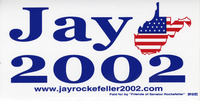 Jay Rockefeller for Senate 2002 Bumper Sticker
Jay Rockefeller for Senate 2002 Bumper Sticker Democratic candidate Jay Rockefeller ran for and was elected as a United States Senator for West Virginia in 1984, 1990, 1996, 2002, and 2008. As a popular candidate, Rockefeller won handily in nearly every senate election in which he ran.
-
 Cecil H. Underwood 1976 Campaign for Governor Bumper Sticker
Cecil H. Underwood 1976 Campaign for Governor Bumper Sticker Cecil Harland Underwood was both the youngest and oldest elected governor in West Virginia's history, being elected at age 34 in 1956 and at age 75 in 1997. His life was a constant back-and-forth between running for public office and working in the public sector. Over his lifetime, Underwood ran in 13 different elections for various political offices including positions in the House of Representatives, the Senate, and Governor (some of which he won, some lost). In between many of these elections, Underwood worked as a professor at universities, he worked in various coal and chemical companies across the state, and was even a president of Betheny College for a time. In his last campaign for reelection as Governor in 2000, Underwood was defeated by Democratic Congressman Bob Wise and retired from the political sphere. In 1976, his third run for Governor, Underwood lost decisively to Democratic nominee Jay Rockefeller.
-
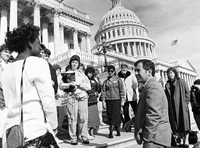 Photograph of Congressman Nick Rahall with constituents at the U.S. Capitol
Photograph of Congressman Nick Rahall with constituents at the U.S. Capitol
-
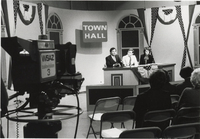 Photograph of Congressman Rahall at a town hall event
Photograph of Congressman Rahall at a town hall event
-
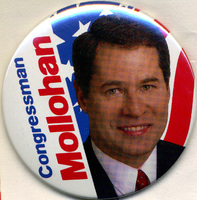 Alan Mollohan Campaign Button 2002
Alan Mollohan Campaign Button 2002 Campaign button from Alan Mollohan's 2002 campaign for U.S. House of Representatives. Mollohan ran unopposed in the general election.
Congressman Alan Mollohan was born in Fairmont, WV on May 14, 1943. He was first elected to the House in 1982. He defeated Democratic primary opponents and Republican John McCuskey. After defeating McCuskey, Mollohan did not usually face strong opponents in re-election bids. However, in 1992 he had to run against incumbent congressman Harley Staggers Jr. The West Virginia population dropped 8 percent. Therefore, the size of the state's House delegation dropped from 4 to 3 members. Mollohan won 13 of 19 counties in the new First District.
As part of the House Appropriations Committee, Mollohan was instrumental to the creation of the West Virginia High Technology Foundation, the Institute for Scientific Research, the Mid-Atlantic Aerospace Complex, and the Canaan Valley Institute.
Mollohan lost his bid for 15th consecutive term in the U.S. House of Representatives on May 11, 2010 to Michael Oliverio, who lost in the general election to Republican David McKinley. He now works for the law firm Nelson Mullens Riley & Scarborough, based in Huntington, West Virginia and Washington, D.C.
-
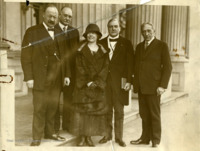 Photograph of Izetta Jewell Brown
Photograph of Izetta Jewell Brown "Senators left the Teapot Dome discussions to wish Mrs. Izetta Jewell Brown, of West Virginia, candidate for Democratic nomination for the Senate, good luck in her campaign. Left to right they are: Sen. Magnus Johnson, Minn., Sen. Andrieus Jones, New Mex., Mrs. Brown, Sen. Tom Heflin, Ala., and Sen. William King, Utah."
-
 Governor Cecil Harland Underwood 1976 Campaign Bumper Sticker
Governor Cecil Harland Underwood 1976 Campaign Bumper Sticker Cecil Underwood was both the youngest and oldest elected governor in West Virginia's history, being elected at age 34 in 1956 and at age 75 in 1997. His life was a constant back-and-forth between running for public office and working in the public sector. Over his lifetime, Underwood ran in 13 different elections for various political offices including positions in the House of Representatives, the Senate, and Governor (some of which he won, some lost). In between many of these elections, Underwood worked as a professor at universities, he worked in various coal and chemical companies across the state, and was even a president of Betheny College for a time. In 1976, his third run for Governor, Underwood lost decisively to Democratic nominee Jay Rockefeller.
-
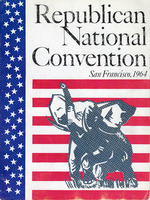 1964 Republican National Convention Program
1964 Republican National Convention Program It was understood by leaders of the Republican Party that there would be some turbulence at the 1964 Convention, given that tensions were already running high amongst members. What they may not have guessed was that they would witness a dramatic shift in their party during this event as a newer, more radical group emerged to take the Party's mantle from the more centrist leadership of old. The 1964 RNC program booklet is evidence of the push for party unity in that most RNC coordinators were preaching togetherness. Page 144-B contends "Republicans have their differences" with some calling themselves "liberals" and some "conservatives." The letters written by many RNC leaders throughout the program echo that call for unification despite the sometimes drastic differences in beliefs by Republicans across the U.S. at the time. This acknowledges the state of the party members and their divisions along issues like civil rights, taxes, and foreign aid that both the traditional party members and the new, more radical members debated over.
-
 Howard V. Corcoran 1964 Republican National Convention Pin
Howard V. Corcoran 1964 Republican National Convention Pin Between 1962 and 1964, Howard V. Corcoran of Wheeling was West Virginia's Republican State Chairman, leading the state's Republicans through a slump in support state wide. In fact, between the 1960 and 1964 major elections, votes for the Republican candidates in West Virginia were reduced by 15%, with only 4 out of 55 counties voting Republican in the 1964 Presidential election. Nonetheless, Corcoran along with two other Republican leaders in the state, Congressman Arch A. Moore, Jr. and Mrs. Perle T. Harman from Bluefield, all represented their state at the 1964 Republican National Convention.
-
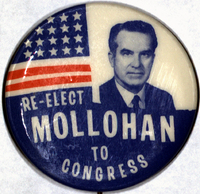 Congressman Mollohan Campaign Button
Congressman Mollohan Campaign Button Campaign button from one of Congressman Robert H. Mollohan's campaigns.
Robert H. Mollohan served nine terms in the U.S. Congress, starting in 1953 and ending in 1982. His House career was interrupted when he ran for Governor against Republican Cecil Underwood in 1956. Underwood defeated him after The Charleston Gazette revealed that he took $20,000 and two cars from a coal operator that stripped land at the Pruntytown reformatory when he was superintendent. "Today, it is not uncommon for candidates for governor to receive hundreds of thousands of dollars in campaign money from coal operators, and it's ok," Mollohan said later. During his time in the House, he was instrumental in helping the Pratt and Whitney Aircraft Service locate at Bridgeport, and helping pass the Emergency Medical Services Act. As a businessman, he was responsible for developing the Ramada Inn in Morgantown.
-
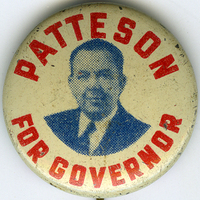 Governor Patteson Campaign Button
Governor Patteson Campaign Button Campaign button from Governor Okey Patteson's campaign for governor in 1948.
Governor Okey Patteson was the 23rd Governor of West Virgnia, winning the election with 57 percent of the votes against Republican opponent Herbert Stephen Boreman. Patterson was a former Fayette County Sheriff and managed Clarence Meadows' successful gubernatorial campaign. Patteson became an assistant to Governor Meadows, and became known as the "Great Persuader." He succeeded Meadows as governor in 1949. As governor, he broke ground for the West Virginia Turnpike, but was best remembered for his controversial decision to place West Virginia's first medical school in Morgantown, West Virginia.
-
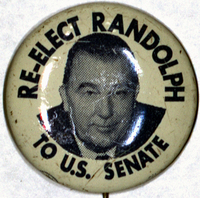 Senator Randolph Campaign Button
Senator Randolph Campaign Button Campaign button from one of Senator Randolph's bids for U.S. Senator from 1960 to 1978.
As a U.S. Senator, Randolph supported the Interstate Highway program and massive road-building efforts. He also sponsored the 1965 Regional Development Act, which created the Appalachian Regional Commission. From 1965 to 1981, Randolph was the chairman of the Public Works Committee, and from 1981 to 1985 he was a ranking minority member. He sponsored legislation to aid the handicapped, compensate victims of black lung disease, ensure clean water and air, and fund vocational and career education. He supported the Civil Rights Act of 1964 and subsequent civil rights legislation. He also sponsored the Constitutional Amendment to allow 18-year-olds to vote 11 times. In 1971, he saw it approved. He was re-elected in 1978 at age 76 with just 50.5 percent of the vote. As this term came to a close, it was uncertain whether he would run for re-election. Then-Governor John D. Rockefeller IV had worked hard for Randolph's re-election in 1978, and was invited to Randolph's Capitol hideaway office one morning. In a 1998 eulogy of Randolph, Rockefeller recalled "He had a very nice breakfast there. He was very relaxed. Then he simply turned to me and said, 'Jay would you like to be the next Senator for West Virginia? '"
-
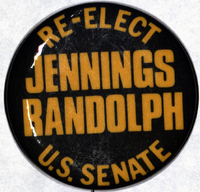 Senator Jennings Randolph Campaign Button
Senator Jennings Randolph Campaign Button Campaign button for one of Senator Jennings Randolph's bids for U.S. Senate from 1960 to 1978.
Jennings Randolph served in the U.S. Congress for 40 years. He was born in Salem, Harrison County. His grandfather, Jesse Randoph, was the first Mayor of Salem, a member of the state legislature, and the founder of Salem College. In 1923, Jennings was elected to Salem College's board of trustees, where he served for 50 years. He worked as a reporter and sports editor for the Clarksburg Telegram as a college student, and after he graduated in 1924, he worked in Charleston for West Virginia Review. In 1926, he became the athletic director at Davis and Elkins College. In 1930, at the age of 28, Randolph ran for Congress in the 2nd District. He lost to a 3-term Republican incumbent by only 1,111 votes. In 1932, he won the seat with 53 percent of the vote. This was part of the FDR landslide. He was a solid supporter of Roosevelt's New Deal, and worked with First Lady Eleanor Roosevelt on a project to create a model town at Arthurdale. He was re-elected in the next six elections, but was defeated in 1946 when Republicans won a big majority in the House.
He became director of public relations at Capital Airlines, which later became part of United Airlines. In January of 1958, U.S. Senator Matthew Neely died. Governor Underwood appointed Representative John Hoblitzell to fill the vacancy until a special election could be held in November. Randolph ran for the seat in November, and defeated former Governor Maryland for the Democratic nomination. He went on to win the general election with 59 percent of the vote. Randolph won the rest of his elections by decent margins until 1978
-
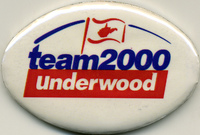 Governor Underwood Campaign Button
Governor Underwood Campaign Button Campaign Button for Governor Underwood's 2000 campaign for re-election.
The Democrats nominated nine-term Congressman Bob Wise of Kanawha County.
In 2000, For the first time since 1916, West Virginia gave support for the Republican candidate for president and the Democratic candidate for governor. President George W. Bush defeated Al Gore 52 percent to 46 percent in West Virginia, but Wise defeated Underwood 50 to 47 percent for the office of governor.
Governor Cecil Underwood was West Virginia's 25th and 32nd governor. He served as the state's youngest and oldest chief executive. He was born in Joseph Mills in Tyler County. He was the youngest of 5. He helped on the farm and studied vocational agriculture in high school. In 1943, he graduated from Salem College with a Bachelor of Arts in Political Science. He then served in the Army Reserve, but due to his fast pulse he never went into active duty. In 1949, he won the election for House of Delegates for Tyler County. He spent 12 years in the house, and became House minority leader in 1949. In 1948, he married Hovah Hall of Grantsville, and in 1952, he obtained his Master's in Political Science from West Virginia University.
In 1956, at age 33, he announced his candidacy for governor. He narrowly defeated Charleston Mayor John T. Copenhaver for the Republican nomination. He went on the win the majority of votes in the general election by 63,681 votes over Robert H. Mollohan, despite a 259,000 Democratic voter registration edge. At his inauguration, he promised to hire qualified personnel, keep taxes to a minimum, reform state purchasing, improve roads, strengthen education, attract new industry, and otherwise advance the state up the ladder.
He was barred from a second consecutive term by the state constitution, so he ran for U.S. Senate in 1960. He lost to Democratic opponent Jennings Randolph by 88,240 votes. He then accepted a position with Iron Creek Coal Company. In January of 1964, he ran governor and lost to Hulet Smith by 77,464 votes. Smith was helped by the landslide victory of Democrat Lyndon Johnson for president. In 1967, Underwood lost to Republican candidate Arch Moore for the nomination for governor. In 1972, he became the president of Bethany College, but in 1975 he resigned in the face of discontent by some members of the faculty.
In 1976, he won the Republican nomination for governor, but lost in the general election to Jay Rockefeller by 242,236 votes.
He remained in the private sector, including holding the position of President of Princess Coal in Huntington until 1996 when he ran for governor, and beat Charlotte Pritt of Kanawha County with 52 percent of the vote. This made Underwood West Virginia's 32nd governor, and the oldest to ever hold the position. In his inaugural address, he emphasized the importance of advanced technology, and improvements in education and healthcare "as the industrial age gives way to the information age." During his term he managed to achieve a lot, even with Democrats controlling both Houses. He is credited with a $565 million reduction of the worker's comp fund deficit, an aggressive road construction program, a high-tech partnership with Verizon telephone company, $1 billion of new sewer and water projects, expansion of children's programs, and assistance to help senior citizens afford prescription drugs.
-
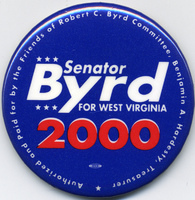 Senator Byrd Campaign Button
Senator Byrd Campaign Button Campaign button from Senator Byrd's 2000 bid for re-election. His opponent was Republican David T. Gallagher. Senator Byrd won with roughly 78 percent of the vote.
During Byrd's time on the Senate Appropriations Committee, he brought the FBI Fingerprinting Identification Center to Clarksburg; IRS offices to Parkersburg; Fish and Wildlife Training to Sheperdstown; the Bureau of Alcohol, Tobacco, and Firearms in Martinsburg; the NASA Research Center in Wheeling; the National White Collar Crime Center in Fairmont and Morgantown; and the National Energy Technology Lab in Morgantown. He also obtained funds for miners who were displaced by the Clean Air Act of 1990, and co-sponsored the unanimously adopted resolution in 1997 opposing the Kyoto Protocol so long as it exempted developing countries. He was one of the members of Congress to bring a lawsuit challenging the constitutionality of the line-item veto enacted in 1996. In June of 1998, the U.S. Supreme Court ruled it unconstitutional. In 2004, he pushed for passage of an amendment that established Constitution Day as a federal observance. All federally funded schools are required to provide educational programming on the history of the U.S. Constitution on September 17, the day the Constitutional Convention signed the Constitution in 1787.
He was elected to his eighth term in 2000 by a 78 percent margin- the third time he had carried all 55 counties in West Virginia. He served as president pro tempore of the Senate, 4th in line to succeed the presidency from 1989 to 1995, and from 2001 to 2003. In 2001, Governor Wise and the West Virginia State Legislature voted Byrd the West Virginian of the 20th Century.
-
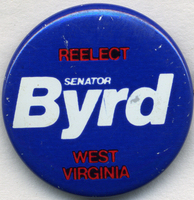 Senator Byrd Campaign Button
Senator Byrd Campaign Button Campaign Button from Senator Byrd's 1982 re-election campaign against freshman Republican Representative, Cleve Benedict.
Benedict was considered Byrd's toughest competitor since election to the Senate.
With Benedict's approval, Benedict supporters presented Byrd with "gifts" publicly as he announced his bid of re-election across the state. In Bluefield, he was presented with membership in the National Conservative Political Action Committee, which had attacked him as a free-spending liberal in television and radio commercials. In Wheeling, they presented him a bus ticket, claiming he had no home in the state. In Martinsburg, they presented him with a bed sheet with two eye holes cut in it, and a preppie alligator sown on it. This was presented to point out the Senator's brief membership with the Klu Klux Klan 35 years prior to the election. Senator Byrd said that the election was about who could do more for West Virginia, a member of the Senate leadership with 24 years experience, or someone with zero years experience who would start out as the number 100 man. Senator Byrd won re-election with 68.5 percent of the votes.
-
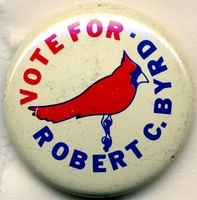 Senator Byrd Campaign Button
Senator Byrd Campaign Button Campaign button for Senator Byrd's campaign for U.S. Senator in 1976. Senator Byrd ran unopposed
Senator Robert C. Byrd was raised by his uncle, Titus Byrd, a coal miner. The family lived in several company towns, in houses with no running water or electricity. He married his high school sweetheart, Erma Ora James, in 1937. He worked in a gas station and grocery store, and learned the meat cutting trade. By the late 1930s, he was working as a butcher for $85 a week. He worked in shipyards in Baltimore and Tampa in World War II, then returned to West Virginia and opened a grocery store in Sophia, Raleigh County.
In 1946 he was elected to the state House of Delegates. During this time he was briefly involved with the Ku Klux Klan. He renounced his membership later in his career. He was re-elected in 1948, and elected to the state Senate in 1950. He won a seat in the U.S. House of Representatives in 1952, and was re-elected in 1954 and 1956. He ran for U.S. Senate in 1958, despite being opposed by coal companies and John L. Lewis, president of the United Mine Workers. He won the Democratic primary and the general election by solid margins, and by wide margins in each election until his death in 2010.
-
 Bumper sticker from Senator Robert C. Byrd's 1980 Presidential Campaign
Bumper sticker from Senator Robert C. Byrd's 1980 Presidential Campaign In 1980, Byrd ran as a "favorite son" or "uncommitted" candidate in West Virginia only, a political strategy that allows a particular state representative control over the delegates from that state as a means of leverage in the election against the convention delegation. In her book, Primary Politics: How Presidential Candidates Have Shaped the Modern Nominating System, Elaine C. Kamarck argues that this strategy's use precipitously dropped in the early 2000s because of its lack of effectiveness as most voters would cast votes for serious candidates in primary elections (153-154). In the earlier 1976 presidential campaign, Byrd also ran as a favorite son, successfully winning West Virginia's primary nomination and the delegates that went along with it. It is unclear if any leverage opportunities were available to him as he only received the backing of 33 out of over 2,300 delegates to the Democratic National Convention. Evidently, Byrd found his run fruitful and in the 1980 election, he decided to run again as a favorite son candidate, leading to the creation of this bumper sticker. In the 1980 primaries, Bryd won none of the delegates and ended his bids for delegates through a favorite son run.
-
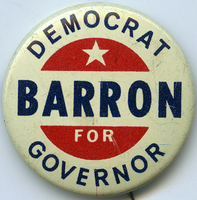 Governor Barron Campaign Button
Governor Barron Campaign Button William Wallace "Wally" Barron was West Virginia's 26th Governor. He was born and raised in Elkins, West Virginia, and received his law degree from West Virginia University in 1941. He served as mayor of Elkins, a member of the West Virginia House of Delegates, and as West Virginia Attorney General. He was elected governor in 1960, beating Republican opponent Harold Neely by 86,110 votes. Barron survived an allegation that he had offered $65,000 to an opponent to stay out of the race. The governor took the oath of office secretly at 12:02 a.m. so that he could immediately sign a 1 cent sales tax that predecessor Governor Underwood had declined to sign. Barron supported Sen. John F. Kennedy in the Democratic primary in West Virginia that year, and in return, President JFK spoke at West Virginia's centennial ceremony in Charleston on June 20, 1963, to a crowd of 10,000 people.
Barron focused on job programs, started the successful West Virginia Youth Science Camp, and in 1964, issued a $200 million bond for highway construction. Barron claimed 14 economic records that year. Barron left office in early 1965 and was considering running in the 1968 election. However, in February 1968, in what became known as the"Valentine Day's Massacre," Barron and five others were indicted by the federal grand jury on bribery-conspiracy charges relating to alleged "dummy corporations." The judge considered acquittal on the basis that Barron acted routinely in signing agreements without intent of wrongdoing. The jury deliberated for 18 hours, and the verdict was Barron innocent and the five others guilty.
In the Summer of 1970, stories began to circulate in the media that the jury had voted 11 to 1 in favor of convicting Barron. The lone holdout was jury foreman Ralph Buckalew. In February of 1971, the federal jury indicted Mr. And Mrs. Barron on charges of bribing the foreman of the jury. The allegation was that Mrs. Barron gave Mrs. Buckalew $25,000 in a brown paper bag as a pay-off. Mrs. Barron was dropped from the indictment, and Barron pleaded guilty and was sentenced to 25 years. He served 4 years.
-
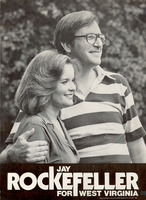 Jay Rockefeller for West Virginia
Jay Rockefeller for West Virginia This is a gubernatorial campaign poster for Jay Rockefeller. Although it does not have a year listed, it only reads "Jay Rockefeller for West Virginia," indicating that Jay had some name recognition at this point in his career, possibly from a prior term as governor. This poster is similar to a campaign poster for Ted Kennedy, a Democratic candidate who lost the 1980 presidential nomination to Jimmy Carter. Both have very simple wording and a black and white image. The bottom of the poster reads, "Paid for by Friends of Governor Rockefeller." This indicates that Rockefeller was already governor of West Virginia at the time of its printing. This poster was most likely from Jay Rockefeller's re-election campaign in 1980.
-
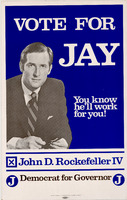 Vote for Jay
Vote for Jay John "Jay" Rockefeller IV was elected to be governor of West Virginia for two terms, in 1976 and 1980. This poster does not have a year, but it does say "Vote for Jay You know he'll work for you!" a simple, yet effective campaign slogan. It also says "Democrat for Governor," indicating that it may be from his first race when a Republican, Arch Moore, had just completed two terms as governor. The poster itself is also very similar in design to Jimmy Carter's 1976 presidential campaign poster. Looking closer at the poster, at the very bottom, there is a "Paid for by the Rockefeller for Governor Committee" stamp.
-
 Make Jay Rockefeller Senator
Make Jay Rockefeller Senator John D. Rockefeller IV, better known as Jay, had a very active career in politics, one that is represented and seen through this poster calling for his election to the Senate. Rockefeller was very active in United States politics while serving his state in the Senate. During his 30 years in Congress, Rockefeller proposed several bills. In 1997, he co-authored the Children's Health Insurance Program (CHIP), to help cover medical costs for low-income children. In 2009, he introduced the Cybersecurity Act. He served as the senior U.S. Senator from West Virginia for five years. With one picture of the candidate in the middle of this poster, surrounded by red , white, and blue, and the political slogan, this poster is reminiscent of President Reagan's re-election posters. Without a date, it isn't possible to say for certain which year this poster is from, considering that Rockefeller served in the Senate from 1985 to 2015. However, this poster does not call for Jay Rockefeller's re-election; it says, "Make Jay Rockefeller Senator." This indicates it is from his first senatorial race in 1984, which he won narrowly as a Democrat when the Republican incumbent President Reagan easily won West Virginia. Combined with the similarities between this poster and other posters in of that year, it is quite possible that this poster is from 1984. The slogan, "Make Washington Work for West Virginia," is also effective. It plays on alliteration with the usage of W's to make it memorable.
-
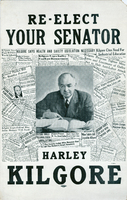 Re-Elect Your Senator Harley Kilgore
Re-Elect Your Senator Harley Kilgore Harley Martin Kilgore was born on January 11, 1893, in Brown, West Virginia, a state that he would spend a majority of his life serving. After earning a law degree from West Virginia University in 1914, Kilgore went on to form the first high school in Raleigh County, WV, where he would serve as the first principal. With the outbreak of World War I, Kilgore joined the army and served as an infantry officer until 1920. Following his service in the Great War, Kilgore organized the West Virginia National Guard in 1921. He would return to Raleigh County in 1933 to serve as the criminal court judge until being elected to the United States Senate in 1940 as a Democrat with the support of Senator Matthew Mansfield Neely.
Kilgore served the state of West Virginia as a senator from 1941 until his death on February 28, 1956. He was re-elected to his position in 1946 and 1952. While in Congress, he chaired the Subcommittee on War Mobilization of the Military Affairs Committee, otherwise known as the Truman Committee, which oversaw U.S. mobilization efforts during World War II. Kilgore continued to act as a U.S. senator until his death, after which he was buried in Arlington National Cemetery.
This poster displays newspaper headlines behind a picture of Senator Kilgore. These headlines show the various positive acts that Kilgore accomplished while in the office of the Senate. It reads "Re-elect your Senator Harley Kilgore," indicating that this poster was from either 1946 or 1952, despite the fact that there is no date on the poster. This poster is reminiscent of Adlai Stevenson's campaign poster for Governor of Illinois in the 1940s. The imagery and the layout show that these campaign posters came from roughly the same time period. Although the political slogan isn't very catchy, it does get the point of the poster across, and the design of the image over the positive newspapers is eye-catching.
-
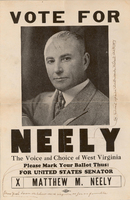 Vote for Neely
Vote for Neely Matthew Mansfield Neely was a native of the state of West Virginia, born on November 9, 1874, in Doddridge County. During the Spanish-American War, Neely served with the First West Virginia Volunteer Infantry. Following the war, he attended West Virginia University to get a law degree. In 1907, Neely was elected Mayor of Fairmont, West Virginia, the beginning of his political career. From 1913 to 1921, Neely began his career in the federal government with four terms as West Virginia's 1st District Representative in the House of Representatives. Following his experience in the House, he began the first of two terms as United States Senator from 1923 to 1929. Neely would eventually again serve in both the Senate and the House of Representatives following his term as West Virginia Governor from 1941 to 1945. Neely died in office on January 18, 1958.
This poster for Neely is undated. Neely ran for a Senate seat many times throughout his political career, being successful in 1922, 1930, and 1948. Because it isn't possible to determine exactly which campaign this poster is from, it is necessary to look at other posters from those time periods. Herbert Hoover's presidential re-election campaign posters are of largely the same style as this Neely poster. The gubernatorial campaign poster for Franklin D. Roosevelt in the state of New York is also very similar to Neely's senatorial poster. Based on the common styles of the time period, it is possible that this poster is from one of Neely's campaigns in the 1930s.
-
 Arch Moore for Congress
Arch Moore for Congress Arch A. Moore, Jr. ran for a Congressional seat seven times, winning six of those and serving as a U.S. Representative from 1957-1969. He also ran for a U.S. Senate seat in 1978, but was unsuccessful. Because this sign does not have a date, it could potentially be from any of those elections, or his failed congressional campaign of 1954. The slogan is not very exciting, despite the eye catching colors of the banner. There is no direct comparison to this banner with any other campaign banner of that stretch of time.
 Jay Rockefeller for Senate 2002 Bumper Sticker Democratic candidate Jay Rockefeller ran for and was elected as a United States Senator for West Virginia in 1984, 1990, 1996, 2002, and 2008. As a popular candidate, Rockefeller won handily in nearly every senate election in which he ran.
Jay Rockefeller for Senate 2002 Bumper Sticker Democratic candidate Jay Rockefeller ran for and was elected as a United States Senator for West Virginia in 1984, 1990, 1996, 2002, and 2008. As a popular candidate, Rockefeller won handily in nearly every senate election in which he ran. Cecil H. Underwood 1976 Campaign for Governor Bumper Sticker Cecil Harland Underwood was both the youngest and oldest elected governor in West Virginia's history, being elected at age 34 in 1956 and at age 75 in 1997. His life was a constant back-and-forth between running for public office and working in the public sector. Over his lifetime, Underwood ran in 13 different elections for various political offices including positions in the House of Representatives, the Senate, and Governor (some of which he won, some lost). In between many of these elections, Underwood worked as a professor at universities, he worked in various coal and chemical companies across the state, and was even a president of Betheny College for a time. In his last campaign for reelection as Governor in 2000, Underwood was defeated by Democratic Congressman Bob Wise and retired from the political sphere. In 1976, his third run for Governor, Underwood lost decisively to Democratic nominee Jay Rockefeller.
Cecil H. Underwood 1976 Campaign for Governor Bumper Sticker Cecil Harland Underwood was both the youngest and oldest elected governor in West Virginia's history, being elected at age 34 in 1956 and at age 75 in 1997. His life was a constant back-and-forth between running for public office and working in the public sector. Over his lifetime, Underwood ran in 13 different elections for various political offices including positions in the House of Representatives, the Senate, and Governor (some of which he won, some lost). In between many of these elections, Underwood worked as a professor at universities, he worked in various coal and chemical companies across the state, and was even a president of Betheny College for a time. In his last campaign for reelection as Governor in 2000, Underwood was defeated by Democratic Congressman Bob Wise and retired from the political sphere. In 1976, his third run for Governor, Underwood lost decisively to Democratic nominee Jay Rockefeller. Photograph of Congressman Nick Rahall with constituents at the U.S. Capitol
Photograph of Congressman Nick Rahall with constituents at the U.S. Capitol  Photograph of Congressman Rahall at a town hall event
Photograph of Congressman Rahall at a town hall event  Alan Mollohan Campaign Button 2002 Campaign button from Alan Mollohan's 2002 campaign for U.S. House of Representatives. Mollohan ran unopposed in the general election. Congressman Alan Mollohan was born in Fairmont, WV on May 14, 1943. He was first elected to the House in 1982. He defeated Democratic primary opponents and Republican John McCuskey. After defeating McCuskey, Mollohan did not usually face strong opponents in re-election bids. However, in 1992 he had to run against incumbent congressman Harley Staggers Jr. The West Virginia population dropped 8 percent. Therefore, the size of the state's House delegation dropped from 4 to 3 members. Mollohan won 13 of 19 counties in the new First District. As part of the House Appropriations Committee, Mollohan was instrumental to the creation of the West Virginia High Technology Foundation, the Institute for Scientific Research, the Mid-Atlantic Aerospace Complex, and the Canaan Valley Institute. Mollohan lost his bid for 15th consecutive term in the U.S. House of Representatives on May 11, 2010 to Michael Oliverio, who lost in the general election to Republican David McKinley. He now works for the law firm Nelson Mullens Riley & Scarborough, based in Huntington, West Virginia and Washington, D.C.
Alan Mollohan Campaign Button 2002 Campaign button from Alan Mollohan's 2002 campaign for U.S. House of Representatives. Mollohan ran unopposed in the general election. Congressman Alan Mollohan was born in Fairmont, WV on May 14, 1943. He was first elected to the House in 1982. He defeated Democratic primary opponents and Republican John McCuskey. After defeating McCuskey, Mollohan did not usually face strong opponents in re-election bids. However, in 1992 he had to run against incumbent congressman Harley Staggers Jr. The West Virginia population dropped 8 percent. Therefore, the size of the state's House delegation dropped from 4 to 3 members. Mollohan won 13 of 19 counties in the new First District. As part of the House Appropriations Committee, Mollohan was instrumental to the creation of the West Virginia High Technology Foundation, the Institute for Scientific Research, the Mid-Atlantic Aerospace Complex, and the Canaan Valley Institute. Mollohan lost his bid for 15th consecutive term in the U.S. House of Representatives on May 11, 2010 to Michael Oliverio, who lost in the general election to Republican David McKinley. He now works for the law firm Nelson Mullens Riley & Scarborough, based in Huntington, West Virginia and Washington, D.C. Photograph of Izetta Jewell Brown "Senators left the Teapot Dome discussions to wish Mrs. Izetta Jewell Brown, of West Virginia, candidate for Democratic nomination for the Senate, good luck in her campaign. Left to right they are: Sen. Magnus Johnson, Minn., Sen. Andrieus Jones, New Mex., Mrs. Brown, Sen. Tom Heflin, Ala., and Sen. William King, Utah."
Photograph of Izetta Jewell Brown "Senators left the Teapot Dome discussions to wish Mrs. Izetta Jewell Brown, of West Virginia, candidate for Democratic nomination for the Senate, good luck in her campaign. Left to right they are: Sen. Magnus Johnson, Minn., Sen. Andrieus Jones, New Mex., Mrs. Brown, Sen. Tom Heflin, Ala., and Sen. William King, Utah." Governor Cecil Harland Underwood 1976 Campaign Bumper Sticker Cecil Underwood was both the youngest and oldest elected governor in West Virginia's history, being elected at age 34 in 1956 and at age 75 in 1997. His life was a constant back-and-forth between running for public office and working in the public sector. Over his lifetime, Underwood ran in 13 different elections for various political offices including positions in the House of Representatives, the Senate, and Governor (some of which he won, some lost). In between many of these elections, Underwood worked as a professor at universities, he worked in various coal and chemical companies across the state, and was even a president of Betheny College for a time. In 1976, his third run for Governor, Underwood lost decisively to Democratic nominee Jay Rockefeller.
Governor Cecil Harland Underwood 1976 Campaign Bumper Sticker Cecil Underwood was both the youngest and oldest elected governor in West Virginia's history, being elected at age 34 in 1956 and at age 75 in 1997. His life was a constant back-and-forth between running for public office and working in the public sector. Over his lifetime, Underwood ran in 13 different elections for various political offices including positions in the House of Representatives, the Senate, and Governor (some of which he won, some lost). In between many of these elections, Underwood worked as a professor at universities, he worked in various coal and chemical companies across the state, and was even a president of Betheny College for a time. In 1976, his third run for Governor, Underwood lost decisively to Democratic nominee Jay Rockefeller. 1964 Republican National Convention Program It was understood by leaders of the Republican Party that there would be some turbulence at the 1964 Convention, given that tensions were already running high amongst members. What they may not have guessed was that they would witness a dramatic shift in their party during this event as a newer, more radical group emerged to take the Party's mantle from the more centrist leadership of old. The 1964 RNC program booklet is evidence of the push for party unity in that most RNC coordinators were preaching togetherness. Page 144-B contends "Republicans have their differences" with some calling themselves "liberals" and some "conservatives." The letters written by many RNC leaders throughout the program echo that call for unification despite the sometimes drastic differences in beliefs by Republicans across the U.S. at the time. This acknowledges the state of the party members and their divisions along issues like civil rights, taxes, and foreign aid that both the traditional party members and the new, more radical members debated over.
1964 Republican National Convention Program It was understood by leaders of the Republican Party that there would be some turbulence at the 1964 Convention, given that tensions were already running high amongst members. What they may not have guessed was that they would witness a dramatic shift in their party during this event as a newer, more radical group emerged to take the Party's mantle from the more centrist leadership of old. The 1964 RNC program booklet is evidence of the push for party unity in that most RNC coordinators were preaching togetherness. Page 144-B contends "Republicans have their differences" with some calling themselves "liberals" and some "conservatives." The letters written by many RNC leaders throughout the program echo that call for unification despite the sometimes drastic differences in beliefs by Republicans across the U.S. at the time. This acknowledges the state of the party members and their divisions along issues like civil rights, taxes, and foreign aid that both the traditional party members and the new, more radical members debated over. Howard V. Corcoran 1964 Republican National Convention Pin Between 1962 and 1964, Howard V. Corcoran of Wheeling was West Virginia's Republican State Chairman, leading the state's Republicans through a slump in support state wide. In fact, between the 1960 and 1964 major elections, votes for the Republican candidates in West Virginia were reduced by 15%, with only 4 out of 55 counties voting Republican in the 1964 Presidential election. Nonetheless, Corcoran along with two other Republican leaders in the state, Congressman Arch A. Moore, Jr. and Mrs. Perle T. Harman from Bluefield, all represented their state at the 1964 Republican National Convention.
Howard V. Corcoran 1964 Republican National Convention Pin Between 1962 and 1964, Howard V. Corcoran of Wheeling was West Virginia's Republican State Chairman, leading the state's Republicans through a slump in support state wide. In fact, between the 1960 and 1964 major elections, votes for the Republican candidates in West Virginia were reduced by 15%, with only 4 out of 55 counties voting Republican in the 1964 Presidential election. Nonetheless, Corcoran along with two other Republican leaders in the state, Congressman Arch A. Moore, Jr. and Mrs. Perle T. Harman from Bluefield, all represented their state at the 1964 Republican National Convention. Congressman Mollohan Campaign Button Campaign button from one of Congressman Robert H. Mollohan's campaigns. Robert H. Mollohan served nine terms in the U.S. Congress, starting in 1953 and ending in 1982. His House career was interrupted when he ran for Governor against Republican Cecil Underwood in 1956. Underwood defeated him after The Charleston Gazette revealed that he took $20,000 and two cars from a coal operator that stripped land at the Pruntytown reformatory when he was superintendent. "Today, it is not uncommon for candidates for governor to receive hundreds of thousands of dollars in campaign money from coal operators, and it's ok," Mollohan said later. During his time in the House, he was instrumental in helping the Pratt and Whitney Aircraft Service locate at Bridgeport, and helping pass the Emergency Medical Services Act. As a businessman, he was responsible for developing the Ramada Inn in Morgantown.
Congressman Mollohan Campaign Button Campaign button from one of Congressman Robert H. Mollohan's campaigns. Robert H. Mollohan served nine terms in the U.S. Congress, starting in 1953 and ending in 1982. His House career was interrupted when he ran for Governor against Republican Cecil Underwood in 1956. Underwood defeated him after The Charleston Gazette revealed that he took $20,000 and two cars from a coal operator that stripped land at the Pruntytown reformatory when he was superintendent. "Today, it is not uncommon for candidates for governor to receive hundreds of thousands of dollars in campaign money from coal operators, and it's ok," Mollohan said later. During his time in the House, he was instrumental in helping the Pratt and Whitney Aircraft Service locate at Bridgeport, and helping pass the Emergency Medical Services Act. As a businessman, he was responsible for developing the Ramada Inn in Morgantown. Governor Patteson Campaign Button Campaign button from Governor Okey Patteson's campaign for governor in 1948. Governor Okey Patteson was the 23rd Governor of West Virgnia, winning the election with 57 percent of the votes against Republican opponent Herbert Stephen Boreman. Patterson was a former Fayette County Sheriff and managed Clarence Meadows' successful gubernatorial campaign. Patteson became an assistant to Governor Meadows, and became known as the "Great Persuader." He succeeded Meadows as governor in 1949. As governor, he broke ground for the West Virginia Turnpike, but was best remembered for his controversial decision to place West Virginia's first medical school in Morgantown, West Virginia.
Governor Patteson Campaign Button Campaign button from Governor Okey Patteson's campaign for governor in 1948. Governor Okey Patteson was the 23rd Governor of West Virgnia, winning the election with 57 percent of the votes against Republican opponent Herbert Stephen Boreman. Patterson was a former Fayette County Sheriff and managed Clarence Meadows' successful gubernatorial campaign. Patteson became an assistant to Governor Meadows, and became known as the "Great Persuader." He succeeded Meadows as governor in 1949. As governor, he broke ground for the West Virginia Turnpike, but was best remembered for his controversial decision to place West Virginia's first medical school in Morgantown, West Virginia. Senator Randolph Campaign Button Campaign button from one of Senator Randolph's bids for U.S. Senator from 1960 to 1978. As a U.S. Senator, Randolph supported the Interstate Highway program and massive road-building efforts. He also sponsored the 1965 Regional Development Act, which created the Appalachian Regional Commission. From 1965 to 1981, Randolph was the chairman of the Public Works Committee, and from 1981 to 1985 he was a ranking minority member. He sponsored legislation to aid the handicapped, compensate victims of black lung disease, ensure clean water and air, and fund vocational and career education. He supported the Civil Rights Act of 1964 and subsequent civil rights legislation. He also sponsored the Constitutional Amendment to allow 18-year-olds to vote 11 times. In 1971, he saw it approved. He was re-elected in 1978 at age 76 with just 50.5 percent of the vote. As this term came to a close, it was uncertain whether he would run for re-election. Then-Governor John D. Rockefeller IV had worked hard for Randolph's re-election in 1978, and was invited to Randolph's Capitol hideaway office one morning. In a 1998 eulogy of Randolph, Rockefeller recalled "He had a very nice breakfast there. He was very relaxed. Then he simply turned to me and said, 'Jay would you like to be the next Senator for West Virginia? '"
Senator Randolph Campaign Button Campaign button from one of Senator Randolph's bids for U.S. Senator from 1960 to 1978. As a U.S. Senator, Randolph supported the Interstate Highway program and massive road-building efforts. He also sponsored the 1965 Regional Development Act, which created the Appalachian Regional Commission. From 1965 to 1981, Randolph was the chairman of the Public Works Committee, and from 1981 to 1985 he was a ranking minority member. He sponsored legislation to aid the handicapped, compensate victims of black lung disease, ensure clean water and air, and fund vocational and career education. He supported the Civil Rights Act of 1964 and subsequent civil rights legislation. He also sponsored the Constitutional Amendment to allow 18-year-olds to vote 11 times. In 1971, he saw it approved. He was re-elected in 1978 at age 76 with just 50.5 percent of the vote. As this term came to a close, it was uncertain whether he would run for re-election. Then-Governor John D. Rockefeller IV had worked hard for Randolph's re-election in 1978, and was invited to Randolph's Capitol hideaway office one morning. In a 1998 eulogy of Randolph, Rockefeller recalled "He had a very nice breakfast there. He was very relaxed. Then he simply turned to me and said, 'Jay would you like to be the next Senator for West Virginia? '" Senator Jennings Randolph Campaign Button Campaign button for one of Senator Jennings Randolph's bids for U.S. Senate from 1960 to 1978. Jennings Randolph served in the U.S. Congress for 40 years. He was born in Salem, Harrison County. His grandfather, Jesse Randoph, was the first Mayor of Salem, a member of the state legislature, and the founder of Salem College. In 1923, Jennings was elected to Salem College's board of trustees, where he served for 50 years. He worked as a reporter and sports editor for the Clarksburg Telegram as a college student, and after he graduated in 1924, he worked in Charleston for West Virginia Review. In 1926, he became the athletic director at Davis and Elkins College. In 1930, at the age of 28, Randolph ran for Congress in the 2nd District. He lost to a 3-term Republican incumbent by only 1,111 votes. In 1932, he won the seat with 53 percent of the vote. This was part of the FDR landslide. He was a solid supporter of Roosevelt's New Deal, and worked with First Lady Eleanor Roosevelt on a project to create a model town at Arthurdale. He was re-elected in the next six elections, but was defeated in 1946 when Republicans won a big majority in the House. He became director of public relations at Capital Airlines, which later became part of United Airlines. In January of 1958, U.S. Senator Matthew Neely died. Governor Underwood appointed Representative John Hoblitzell to fill the vacancy until a special election could be held in November. Randolph ran for the seat in November, and defeated former Governor Maryland for the Democratic nomination. He went on to win the general election with 59 percent of the vote. Randolph won the rest of his elections by decent margins until 1978
Senator Jennings Randolph Campaign Button Campaign button for one of Senator Jennings Randolph's bids for U.S. Senate from 1960 to 1978. Jennings Randolph served in the U.S. Congress for 40 years. He was born in Salem, Harrison County. His grandfather, Jesse Randoph, was the first Mayor of Salem, a member of the state legislature, and the founder of Salem College. In 1923, Jennings was elected to Salem College's board of trustees, where he served for 50 years. He worked as a reporter and sports editor for the Clarksburg Telegram as a college student, and after he graduated in 1924, he worked in Charleston for West Virginia Review. In 1926, he became the athletic director at Davis and Elkins College. In 1930, at the age of 28, Randolph ran for Congress in the 2nd District. He lost to a 3-term Republican incumbent by only 1,111 votes. In 1932, he won the seat with 53 percent of the vote. This was part of the FDR landslide. He was a solid supporter of Roosevelt's New Deal, and worked with First Lady Eleanor Roosevelt on a project to create a model town at Arthurdale. He was re-elected in the next six elections, but was defeated in 1946 when Republicans won a big majority in the House. He became director of public relations at Capital Airlines, which later became part of United Airlines. In January of 1958, U.S. Senator Matthew Neely died. Governor Underwood appointed Representative John Hoblitzell to fill the vacancy until a special election could be held in November. Randolph ran for the seat in November, and defeated former Governor Maryland for the Democratic nomination. He went on to win the general election with 59 percent of the vote. Randolph won the rest of his elections by decent margins until 1978 Governor Underwood Campaign Button Campaign Button for Governor Underwood's 2000 campaign for re-election. The Democrats nominated nine-term Congressman Bob Wise of Kanawha County. In 2000, For the first time since 1916, West Virginia gave support for the Republican candidate for president and the Democratic candidate for governor. President George W. Bush defeated Al Gore 52 percent to 46 percent in West Virginia, but Wise defeated Underwood 50 to 47 percent for the office of governor. Governor Cecil Underwood was West Virginia's 25th and 32nd governor. He served as the state's youngest and oldest chief executive. He was born in Joseph Mills in Tyler County. He was the youngest of 5. He helped on the farm and studied vocational agriculture in high school. In 1943, he graduated from Salem College with a Bachelor of Arts in Political Science. He then served in the Army Reserve, but due to his fast pulse he never went into active duty. In 1949, he won the election for House of Delegates for Tyler County. He spent 12 years in the house, and became House minority leader in 1949. In 1948, he married Hovah Hall of Grantsville, and in 1952, he obtained his Master's in Political Science from West Virginia University. In 1956, at age 33, he announced his candidacy for governor. He narrowly defeated Charleston Mayor John T. Copenhaver for the Republican nomination. He went on the win the majority of votes in the general election by 63,681 votes over Robert H. Mollohan, despite a 259,000 Democratic voter registration edge. At his inauguration, he promised to hire qualified personnel, keep taxes to a minimum, reform state purchasing, improve roads, strengthen education, attract new industry, and otherwise advance the state up the ladder. He was barred from a second consecutive term by the state constitution, so he ran for U.S. Senate in 1960. He lost to Democratic opponent Jennings Randolph by 88,240 votes. He then accepted a position with Iron Creek Coal Company. In January of 1964, he ran governor and lost to Hulet Smith by 77,464 votes. Smith was helped by the landslide victory of Democrat Lyndon Johnson for president. In 1967, Underwood lost to Republican candidate Arch Moore for the nomination for governor. In 1972, he became the president of Bethany College, but in 1975 he resigned in the face of discontent by some members of the faculty. In 1976, he won the Republican nomination for governor, but lost in the general election to Jay Rockefeller by 242,236 votes. He remained in the private sector, including holding the position of President of Princess Coal in Huntington until 1996 when he ran for governor, and beat Charlotte Pritt of Kanawha County with 52 percent of the vote. This made Underwood West Virginia's 32nd governor, and the oldest to ever hold the position. In his inaugural address, he emphasized the importance of advanced technology, and improvements in education and healthcare "as the industrial age gives way to the information age." During his term he managed to achieve a lot, even with Democrats controlling both Houses. He is credited with a $565 million reduction of the worker's comp fund deficit, an aggressive road construction program, a high-tech partnership with Verizon telephone company, $1 billion of new sewer and water projects, expansion of children's programs, and assistance to help senior citizens afford prescription drugs.
Governor Underwood Campaign Button Campaign Button for Governor Underwood's 2000 campaign for re-election. The Democrats nominated nine-term Congressman Bob Wise of Kanawha County. In 2000, For the first time since 1916, West Virginia gave support for the Republican candidate for president and the Democratic candidate for governor. President George W. Bush defeated Al Gore 52 percent to 46 percent in West Virginia, but Wise defeated Underwood 50 to 47 percent for the office of governor. Governor Cecil Underwood was West Virginia's 25th and 32nd governor. He served as the state's youngest and oldest chief executive. He was born in Joseph Mills in Tyler County. He was the youngest of 5. He helped on the farm and studied vocational agriculture in high school. In 1943, he graduated from Salem College with a Bachelor of Arts in Political Science. He then served in the Army Reserve, but due to his fast pulse he never went into active duty. In 1949, he won the election for House of Delegates for Tyler County. He spent 12 years in the house, and became House minority leader in 1949. In 1948, he married Hovah Hall of Grantsville, and in 1952, he obtained his Master's in Political Science from West Virginia University. In 1956, at age 33, he announced his candidacy for governor. He narrowly defeated Charleston Mayor John T. Copenhaver for the Republican nomination. He went on the win the majority of votes in the general election by 63,681 votes over Robert H. Mollohan, despite a 259,000 Democratic voter registration edge. At his inauguration, he promised to hire qualified personnel, keep taxes to a minimum, reform state purchasing, improve roads, strengthen education, attract new industry, and otherwise advance the state up the ladder. He was barred from a second consecutive term by the state constitution, so he ran for U.S. Senate in 1960. He lost to Democratic opponent Jennings Randolph by 88,240 votes. He then accepted a position with Iron Creek Coal Company. In January of 1964, he ran governor and lost to Hulet Smith by 77,464 votes. Smith was helped by the landslide victory of Democrat Lyndon Johnson for president. In 1967, Underwood lost to Republican candidate Arch Moore for the nomination for governor. In 1972, he became the president of Bethany College, but in 1975 he resigned in the face of discontent by some members of the faculty. In 1976, he won the Republican nomination for governor, but lost in the general election to Jay Rockefeller by 242,236 votes. He remained in the private sector, including holding the position of President of Princess Coal in Huntington until 1996 when he ran for governor, and beat Charlotte Pritt of Kanawha County with 52 percent of the vote. This made Underwood West Virginia's 32nd governor, and the oldest to ever hold the position. In his inaugural address, he emphasized the importance of advanced technology, and improvements in education and healthcare "as the industrial age gives way to the information age." During his term he managed to achieve a lot, even with Democrats controlling both Houses. He is credited with a $565 million reduction of the worker's comp fund deficit, an aggressive road construction program, a high-tech partnership with Verizon telephone company, $1 billion of new sewer and water projects, expansion of children's programs, and assistance to help senior citizens afford prescription drugs. Senator Byrd Campaign Button Campaign button from Senator Byrd's 2000 bid for re-election. His opponent was Republican David T. Gallagher. Senator Byrd won with roughly 78 percent of the vote. During Byrd's time on the Senate Appropriations Committee, he brought the FBI Fingerprinting Identification Center to Clarksburg; IRS offices to Parkersburg; Fish and Wildlife Training to Sheperdstown; the Bureau of Alcohol, Tobacco, and Firearms in Martinsburg; the NASA Research Center in Wheeling; the National White Collar Crime Center in Fairmont and Morgantown; and the National Energy Technology Lab in Morgantown. He also obtained funds for miners who were displaced by the Clean Air Act of 1990, and co-sponsored the unanimously adopted resolution in 1997 opposing the Kyoto Protocol so long as it exempted developing countries. He was one of the members of Congress to bring a lawsuit challenging the constitutionality of the line-item veto enacted in 1996. In June of 1998, the U.S. Supreme Court ruled it unconstitutional. In 2004, he pushed for passage of an amendment that established Constitution Day as a federal observance. All federally funded schools are required to provide educational programming on the history of the U.S. Constitution on September 17, the day the Constitutional Convention signed the Constitution in 1787. He was elected to his eighth term in 2000 by a 78 percent margin- the third time he had carried all 55 counties in West Virginia. He served as president pro tempore of the Senate, 4th in line to succeed the presidency from 1989 to 1995, and from 2001 to 2003. In 2001, Governor Wise and the West Virginia State Legislature voted Byrd the West Virginian of the 20th Century.
Senator Byrd Campaign Button Campaign button from Senator Byrd's 2000 bid for re-election. His opponent was Republican David T. Gallagher. Senator Byrd won with roughly 78 percent of the vote. During Byrd's time on the Senate Appropriations Committee, he brought the FBI Fingerprinting Identification Center to Clarksburg; IRS offices to Parkersburg; Fish and Wildlife Training to Sheperdstown; the Bureau of Alcohol, Tobacco, and Firearms in Martinsburg; the NASA Research Center in Wheeling; the National White Collar Crime Center in Fairmont and Morgantown; and the National Energy Technology Lab in Morgantown. He also obtained funds for miners who were displaced by the Clean Air Act of 1990, and co-sponsored the unanimously adopted resolution in 1997 opposing the Kyoto Protocol so long as it exempted developing countries. He was one of the members of Congress to bring a lawsuit challenging the constitutionality of the line-item veto enacted in 1996. In June of 1998, the U.S. Supreme Court ruled it unconstitutional. In 2004, he pushed for passage of an amendment that established Constitution Day as a federal observance. All federally funded schools are required to provide educational programming on the history of the U.S. Constitution on September 17, the day the Constitutional Convention signed the Constitution in 1787. He was elected to his eighth term in 2000 by a 78 percent margin- the third time he had carried all 55 counties in West Virginia. He served as president pro tempore of the Senate, 4th in line to succeed the presidency from 1989 to 1995, and from 2001 to 2003. In 2001, Governor Wise and the West Virginia State Legislature voted Byrd the West Virginian of the 20th Century. Senator Byrd Campaign Button Campaign Button from Senator Byrd's 1982 re-election campaign against freshman Republican Representative, Cleve Benedict. Benedict was considered Byrd's toughest competitor since election to the Senate. With Benedict's approval, Benedict supporters presented Byrd with "gifts" publicly as he announced his bid of re-election across the state. In Bluefield, he was presented with membership in the National Conservative Political Action Committee, which had attacked him as a free-spending liberal in television and radio commercials. In Wheeling, they presented him a bus ticket, claiming he had no home in the state. In Martinsburg, they presented him with a bed sheet with two eye holes cut in it, and a preppie alligator sown on it. This was presented to point out the Senator's brief membership with the Klu Klux Klan 35 years prior to the election. Senator Byrd said that the election was about who could do more for West Virginia, a member of the Senate leadership with 24 years experience, or someone with zero years experience who would start out as the number 100 man. Senator Byrd won re-election with 68.5 percent of the votes.
Senator Byrd Campaign Button Campaign Button from Senator Byrd's 1982 re-election campaign against freshman Republican Representative, Cleve Benedict. Benedict was considered Byrd's toughest competitor since election to the Senate. With Benedict's approval, Benedict supporters presented Byrd with "gifts" publicly as he announced his bid of re-election across the state. In Bluefield, he was presented with membership in the National Conservative Political Action Committee, which had attacked him as a free-spending liberal in television and radio commercials. In Wheeling, they presented him a bus ticket, claiming he had no home in the state. In Martinsburg, they presented him with a bed sheet with two eye holes cut in it, and a preppie alligator sown on it. This was presented to point out the Senator's brief membership with the Klu Klux Klan 35 years prior to the election. Senator Byrd said that the election was about who could do more for West Virginia, a member of the Senate leadership with 24 years experience, or someone with zero years experience who would start out as the number 100 man. Senator Byrd won re-election with 68.5 percent of the votes. Senator Byrd Campaign Button Campaign button for Senator Byrd's campaign for U.S. Senator in 1976. Senator Byrd ran unopposed Senator Robert C. Byrd was raised by his uncle, Titus Byrd, a coal miner. The family lived in several company towns, in houses with no running water or electricity. He married his high school sweetheart, Erma Ora James, in 1937. He worked in a gas station and grocery store, and learned the meat cutting trade. By the late 1930s, he was working as a butcher for $85 a week. He worked in shipyards in Baltimore and Tampa in World War II, then returned to West Virginia and opened a grocery store in Sophia, Raleigh County. In 1946 he was elected to the state House of Delegates. During this time he was briefly involved with the Ku Klux Klan. He renounced his membership later in his career. He was re-elected in 1948, and elected to the state Senate in 1950. He won a seat in the U.S. House of Representatives in 1952, and was re-elected in 1954 and 1956. He ran for U.S. Senate in 1958, despite being opposed by coal companies and John L. Lewis, president of the United Mine Workers. He won the Democratic primary and the general election by solid margins, and by wide margins in each election until his death in 2010.
Senator Byrd Campaign Button Campaign button for Senator Byrd's campaign for U.S. Senator in 1976. Senator Byrd ran unopposed Senator Robert C. Byrd was raised by his uncle, Titus Byrd, a coal miner. The family lived in several company towns, in houses with no running water or electricity. He married his high school sweetheart, Erma Ora James, in 1937. He worked in a gas station and grocery store, and learned the meat cutting trade. By the late 1930s, he was working as a butcher for $85 a week. He worked in shipyards in Baltimore and Tampa in World War II, then returned to West Virginia and opened a grocery store in Sophia, Raleigh County. In 1946 he was elected to the state House of Delegates. During this time he was briefly involved with the Ku Klux Klan. He renounced his membership later in his career. He was re-elected in 1948, and elected to the state Senate in 1950. He won a seat in the U.S. House of Representatives in 1952, and was re-elected in 1954 and 1956. He ran for U.S. Senate in 1958, despite being opposed by coal companies and John L. Lewis, president of the United Mine Workers. He won the Democratic primary and the general election by solid margins, and by wide margins in each election until his death in 2010. Bumper sticker from Senator Robert C. Byrd's 1980 Presidential Campaign In 1980, Byrd ran as a "favorite son" or "uncommitted" candidate in West Virginia only, a political strategy that allows a particular state representative control over the delegates from that state as a means of leverage in the election against the convention delegation. In her book, Primary Politics: How Presidential Candidates Have Shaped the Modern Nominating System, Elaine C. Kamarck argues that this strategy's use precipitously dropped in the early 2000s because of its lack of effectiveness as most voters would cast votes for serious candidates in primary elections (153-154). In the earlier 1976 presidential campaign, Byrd also ran as a favorite son, successfully winning West Virginia's primary nomination and the delegates that went along with it. It is unclear if any leverage opportunities were available to him as he only received the backing of 33 out of over 2,300 delegates to the Democratic National Convention. Evidently, Byrd found his run fruitful and in the 1980 election, he decided to run again as a favorite son candidate, leading to the creation of this bumper sticker. In the 1980 primaries, Bryd won none of the delegates and ended his bids for delegates through a favorite son run.
Bumper sticker from Senator Robert C. Byrd's 1980 Presidential Campaign In 1980, Byrd ran as a "favorite son" or "uncommitted" candidate in West Virginia only, a political strategy that allows a particular state representative control over the delegates from that state as a means of leverage in the election against the convention delegation. In her book, Primary Politics: How Presidential Candidates Have Shaped the Modern Nominating System, Elaine C. Kamarck argues that this strategy's use precipitously dropped in the early 2000s because of its lack of effectiveness as most voters would cast votes for serious candidates in primary elections (153-154). In the earlier 1976 presidential campaign, Byrd also ran as a favorite son, successfully winning West Virginia's primary nomination and the delegates that went along with it. It is unclear if any leverage opportunities were available to him as he only received the backing of 33 out of over 2,300 delegates to the Democratic National Convention. Evidently, Byrd found his run fruitful and in the 1980 election, he decided to run again as a favorite son candidate, leading to the creation of this bumper sticker. In the 1980 primaries, Bryd won none of the delegates and ended his bids for delegates through a favorite son run. Governor Barron Campaign Button William Wallace "Wally" Barron was West Virginia's 26th Governor. He was born and raised in Elkins, West Virginia, and received his law degree from West Virginia University in 1941. He served as mayor of Elkins, a member of the West Virginia House of Delegates, and as West Virginia Attorney General. He was elected governor in 1960, beating Republican opponent Harold Neely by 86,110 votes. Barron survived an allegation that he had offered $65,000 to an opponent to stay out of the race. The governor took the oath of office secretly at 12:02 a.m. so that he could immediately sign a 1 cent sales tax that predecessor Governor Underwood had declined to sign. Barron supported Sen. John F. Kennedy in the Democratic primary in West Virginia that year, and in return, President JFK spoke at West Virginia's centennial ceremony in Charleston on June 20, 1963, to a crowd of 10,000 people. Barron focused on job programs, started the successful West Virginia Youth Science Camp, and in 1964, issued a $200 million bond for highway construction. Barron claimed 14 economic records that year. Barron left office in early 1965 and was considering running in the 1968 election. However, in February 1968, in what became known as the"Valentine Day's Massacre," Barron and five others were indicted by the federal grand jury on bribery-conspiracy charges relating to alleged "dummy corporations." The judge considered acquittal on the basis that Barron acted routinely in signing agreements without intent of wrongdoing. The jury deliberated for 18 hours, and the verdict was Barron innocent and the five others guilty. In the Summer of 1970, stories began to circulate in the media that the jury had voted 11 to 1 in favor of convicting Barron. The lone holdout was jury foreman Ralph Buckalew. In February of 1971, the federal jury indicted Mr. And Mrs. Barron on charges of bribing the foreman of the jury. The allegation was that Mrs. Barron gave Mrs. Buckalew $25,000 in a brown paper bag as a pay-off. Mrs. Barron was dropped from the indictment, and Barron pleaded guilty and was sentenced to 25 years. He served 4 years.
Governor Barron Campaign Button William Wallace "Wally" Barron was West Virginia's 26th Governor. He was born and raised in Elkins, West Virginia, and received his law degree from West Virginia University in 1941. He served as mayor of Elkins, a member of the West Virginia House of Delegates, and as West Virginia Attorney General. He was elected governor in 1960, beating Republican opponent Harold Neely by 86,110 votes. Barron survived an allegation that he had offered $65,000 to an opponent to stay out of the race. The governor took the oath of office secretly at 12:02 a.m. so that he could immediately sign a 1 cent sales tax that predecessor Governor Underwood had declined to sign. Barron supported Sen. John F. Kennedy in the Democratic primary in West Virginia that year, and in return, President JFK spoke at West Virginia's centennial ceremony in Charleston on June 20, 1963, to a crowd of 10,000 people. Barron focused on job programs, started the successful West Virginia Youth Science Camp, and in 1964, issued a $200 million bond for highway construction. Barron claimed 14 economic records that year. Barron left office in early 1965 and was considering running in the 1968 election. However, in February 1968, in what became known as the"Valentine Day's Massacre," Barron and five others were indicted by the federal grand jury on bribery-conspiracy charges relating to alleged "dummy corporations." The judge considered acquittal on the basis that Barron acted routinely in signing agreements without intent of wrongdoing. The jury deliberated for 18 hours, and the verdict was Barron innocent and the five others guilty. In the Summer of 1970, stories began to circulate in the media that the jury had voted 11 to 1 in favor of convicting Barron. The lone holdout was jury foreman Ralph Buckalew. In February of 1971, the federal jury indicted Mr. And Mrs. Barron on charges of bribing the foreman of the jury. The allegation was that Mrs. Barron gave Mrs. Buckalew $25,000 in a brown paper bag as a pay-off. Mrs. Barron was dropped from the indictment, and Barron pleaded guilty and was sentenced to 25 years. He served 4 years. Jay Rockefeller for West Virginia This is a gubernatorial campaign poster for Jay Rockefeller. Although it does not have a year listed, it only reads "Jay Rockefeller for West Virginia," indicating that Jay had some name recognition at this point in his career, possibly from a prior term as governor. This poster is similar to a campaign poster for Ted Kennedy, a Democratic candidate who lost the 1980 presidential nomination to Jimmy Carter. Both have very simple wording and a black and white image. The bottom of the poster reads, "Paid for by Friends of Governor Rockefeller." This indicates that Rockefeller was already governor of West Virginia at the time of its printing. This poster was most likely from Jay Rockefeller's re-election campaign in 1980.
Jay Rockefeller for West Virginia This is a gubernatorial campaign poster for Jay Rockefeller. Although it does not have a year listed, it only reads "Jay Rockefeller for West Virginia," indicating that Jay had some name recognition at this point in his career, possibly from a prior term as governor. This poster is similar to a campaign poster for Ted Kennedy, a Democratic candidate who lost the 1980 presidential nomination to Jimmy Carter. Both have very simple wording and a black and white image. The bottom of the poster reads, "Paid for by Friends of Governor Rockefeller." This indicates that Rockefeller was already governor of West Virginia at the time of its printing. This poster was most likely from Jay Rockefeller's re-election campaign in 1980. Vote for Jay John "Jay" Rockefeller IV was elected to be governor of West Virginia for two terms, in 1976 and 1980. This poster does not have a year, but it does say "Vote for Jay You know he'll work for you!" a simple, yet effective campaign slogan. It also says "Democrat for Governor," indicating that it may be from his first race when a Republican, Arch Moore, had just completed two terms as governor. The poster itself is also very similar in design to Jimmy Carter's 1976 presidential campaign poster. Looking closer at the poster, at the very bottom, there is a "Paid for by the Rockefeller for Governor Committee" stamp.
Vote for Jay John "Jay" Rockefeller IV was elected to be governor of West Virginia for two terms, in 1976 and 1980. This poster does not have a year, but it does say "Vote for Jay You know he'll work for you!" a simple, yet effective campaign slogan. It also says "Democrat for Governor," indicating that it may be from his first race when a Republican, Arch Moore, had just completed two terms as governor. The poster itself is also very similar in design to Jimmy Carter's 1976 presidential campaign poster. Looking closer at the poster, at the very bottom, there is a "Paid for by the Rockefeller for Governor Committee" stamp. Make Jay Rockefeller Senator John D. Rockefeller IV, better known as Jay, had a very active career in politics, one that is represented and seen through this poster calling for his election to the Senate. Rockefeller was very active in United States politics while serving his state in the Senate. During his 30 years in Congress, Rockefeller proposed several bills. In 1997, he co-authored the Children's Health Insurance Program (CHIP), to help cover medical costs for low-income children. In 2009, he introduced the Cybersecurity Act. He served as the senior U.S. Senator from West Virginia for five years. With one picture of the candidate in the middle of this poster, surrounded by red , white, and blue, and the political slogan, this poster is reminiscent of President Reagan's re-election posters. Without a date, it isn't possible to say for certain which year this poster is from, considering that Rockefeller served in the Senate from 1985 to 2015. However, this poster does not call for Jay Rockefeller's re-election; it says, "Make Jay Rockefeller Senator." This indicates it is from his first senatorial race in 1984, which he won narrowly as a Democrat when the Republican incumbent President Reagan easily won West Virginia. Combined with the similarities between this poster and other posters in of that year, it is quite possible that this poster is from 1984. The slogan, "Make Washington Work for West Virginia," is also effective. It plays on alliteration with the usage of W's to make it memorable.
Make Jay Rockefeller Senator John D. Rockefeller IV, better known as Jay, had a very active career in politics, one that is represented and seen through this poster calling for his election to the Senate. Rockefeller was very active in United States politics while serving his state in the Senate. During his 30 years in Congress, Rockefeller proposed several bills. In 1997, he co-authored the Children's Health Insurance Program (CHIP), to help cover medical costs for low-income children. In 2009, he introduced the Cybersecurity Act. He served as the senior U.S. Senator from West Virginia for five years. With one picture of the candidate in the middle of this poster, surrounded by red , white, and blue, and the political slogan, this poster is reminiscent of President Reagan's re-election posters. Without a date, it isn't possible to say for certain which year this poster is from, considering that Rockefeller served in the Senate from 1985 to 2015. However, this poster does not call for Jay Rockefeller's re-election; it says, "Make Jay Rockefeller Senator." This indicates it is from his first senatorial race in 1984, which he won narrowly as a Democrat when the Republican incumbent President Reagan easily won West Virginia. Combined with the similarities between this poster and other posters in of that year, it is quite possible that this poster is from 1984. The slogan, "Make Washington Work for West Virginia," is also effective. It plays on alliteration with the usage of W's to make it memorable. Re-Elect Your Senator Harley Kilgore Harley Martin Kilgore was born on January 11, 1893, in Brown, West Virginia, a state that he would spend a majority of his life serving. After earning a law degree from West Virginia University in 1914, Kilgore went on to form the first high school in Raleigh County, WV, where he would serve as the first principal. With the outbreak of World War I, Kilgore joined the army and served as an infantry officer until 1920. Following his service in the Great War, Kilgore organized the West Virginia National Guard in 1921. He would return to Raleigh County in 1933 to serve as the criminal court judge until being elected to the United States Senate in 1940 as a Democrat with the support of Senator Matthew Mansfield Neely. Kilgore served the state of West Virginia as a senator from 1941 until his death on February 28, 1956. He was re-elected to his position in 1946 and 1952. While in Congress, he chaired the Subcommittee on War Mobilization of the Military Affairs Committee, otherwise known as the Truman Committee, which oversaw U.S. mobilization efforts during World War II. Kilgore continued to act as a U.S. senator until his death, after which he was buried in Arlington National Cemetery. This poster displays newspaper headlines behind a picture of Senator Kilgore. These headlines show the various positive acts that Kilgore accomplished while in the office of the Senate. It reads "Re-elect your Senator Harley Kilgore," indicating that this poster was from either 1946 or 1952, despite the fact that there is no date on the poster. This poster is reminiscent of Adlai Stevenson's campaign poster for Governor of Illinois in the 1940s. The imagery and the layout show that these campaign posters came from roughly the same time period. Although the political slogan isn't very catchy, it does get the point of the poster across, and the design of the image over the positive newspapers is eye-catching.
Re-Elect Your Senator Harley Kilgore Harley Martin Kilgore was born on January 11, 1893, in Brown, West Virginia, a state that he would spend a majority of his life serving. After earning a law degree from West Virginia University in 1914, Kilgore went on to form the first high school in Raleigh County, WV, where he would serve as the first principal. With the outbreak of World War I, Kilgore joined the army and served as an infantry officer until 1920. Following his service in the Great War, Kilgore organized the West Virginia National Guard in 1921. He would return to Raleigh County in 1933 to serve as the criminal court judge until being elected to the United States Senate in 1940 as a Democrat with the support of Senator Matthew Mansfield Neely. Kilgore served the state of West Virginia as a senator from 1941 until his death on February 28, 1956. He was re-elected to his position in 1946 and 1952. While in Congress, he chaired the Subcommittee on War Mobilization of the Military Affairs Committee, otherwise known as the Truman Committee, which oversaw U.S. mobilization efforts during World War II. Kilgore continued to act as a U.S. senator until his death, after which he was buried in Arlington National Cemetery. This poster displays newspaper headlines behind a picture of Senator Kilgore. These headlines show the various positive acts that Kilgore accomplished while in the office of the Senate. It reads "Re-elect your Senator Harley Kilgore," indicating that this poster was from either 1946 or 1952, despite the fact that there is no date on the poster. This poster is reminiscent of Adlai Stevenson's campaign poster for Governor of Illinois in the 1940s. The imagery and the layout show that these campaign posters came from roughly the same time period. Although the political slogan isn't very catchy, it does get the point of the poster across, and the design of the image over the positive newspapers is eye-catching. Vote for Neely Matthew Mansfield Neely was a native of the state of West Virginia, born on November 9, 1874, in Doddridge County. During the Spanish-American War, Neely served with the First West Virginia Volunteer Infantry. Following the war, he attended West Virginia University to get a law degree. In 1907, Neely was elected Mayor of Fairmont, West Virginia, the beginning of his political career. From 1913 to 1921, Neely began his career in the federal government with four terms as West Virginia's 1st District Representative in the House of Representatives. Following his experience in the House, he began the first of two terms as United States Senator from 1923 to 1929. Neely would eventually again serve in both the Senate and the House of Representatives following his term as West Virginia Governor from 1941 to 1945. Neely died in office on January 18, 1958. This poster for Neely is undated. Neely ran for a Senate seat many times throughout his political career, being successful in 1922, 1930, and 1948. Because it isn't possible to determine exactly which campaign this poster is from, it is necessary to look at other posters from those time periods. Herbert Hoover's presidential re-election campaign posters are of largely the same style as this Neely poster. The gubernatorial campaign poster for Franklin D. Roosevelt in the state of New York is also very similar to Neely's senatorial poster. Based on the common styles of the time period, it is possible that this poster is from one of Neely's campaigns in the 1930s.
Vote for Neely Matthew Mansfield Neely was a native of the state of West Virginia, born on November 9, 1874, in Doddridge County. During the Spanish-American War, Neely served with the First West Virginia Volunteer Infantry. Following the war, he attended West Virginia University to get a law degree. In 1907, Neely was elected Mayor of Fairmont, West Virginia, the beginning of his political career. From 1913 to 1921, Neely began his career in the federal government with four terms as West Virginia's 1st District Representative in the House of Representatives. Following his experience in the House, he began the first of two terms as United States Senator from 1923 to 1929. Neely would eventually again serve in both the Senate and the House of Representatives following his term as West Virginia Governor from 1941 to 1945. Neely died in office on January 18, 1958. This poster for Neely is undated. Neely ran for a Senate seat many times throughout his political career, being successful in 1922, 1930, and 1948. Because it isn't possible to determine exactly which campaign this poster is from, it is necessary to look at other posters from those time periods. Herbert Hoover's presidential re-election campaign posters are of largely the same style as this Neely poster. The gubernatorial campaign poster for Franklin D. Roosevelt in the state of New York is also very similar to Neely's senatorial poster. Based on the common styles of the time period, it is possible that this poster is from one of Neely's campaigns in the 1930s. Arch Moore for Congress Arch A. Moore, Jr. ran for a Congressional seat seven times, winning six of those and serving as a U.S. Representative from 1957-1969. He also ran for a U.S. Senate seat in 1978, but was unsuccessful. Because this sign does not have a date, it could potentially be from any of those elections, or his failed congressional campaign of 1954. The slogan is not very exciting, despite the eye catching colors of the banner. There is no direct comparison to this banner with any other campaign banner of that stretch of time.
Arch Moore for Congress Arch A. Moore, Jr. ran for a Congressional seat seven times, winning six of those and serving as a U.S. Representative from 1957-1969. He also ran for a U.S. Senate seat in 1978, but was unsuccessful. Because this sign does not have a date, it could potentially be from any of those elections, or his failed congressional campaign of 1954. The slogan is not very exciting, despite the eye catching colors of the banner. There is no direct comparison to this banner with any other campaign banner of that stretch of time.